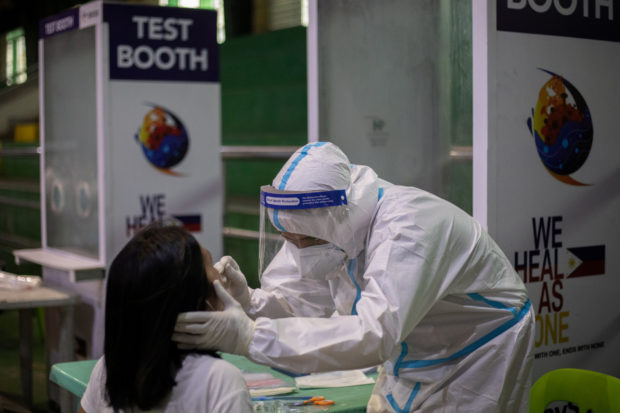
FILE PHOTO: A health worker conducts a coronavirus disease (COVID-19) swab testing at a gymnasium in Navotas City, Metro Manila, Philippines, August 7, 2020. REUTERS/Eloisa Lopez
MANILA, Philippines — The University of the Philippines (UP) research team studying the country’s COVID-19 situation noted several improvements in the country’s fight against the pandemic in recent weeks, but stressed that efforts should be sustained as the developments are still fragile.
According to OCTA Research, a group of academics from UP doing COVID-19 research with the help of the University of Santo Tomas and Providence College in the United States, the country was able to keep coronavirus reproduction rates or R-naught numbers below 1 — 0.87, which is within the desired figure.
Reproduction rates within the National Capital Region, considered as the epicenter of COVID-19 cases in the country, is slightly higher but still below 1.
But despite the improvements, OCTA Research reminded authorities that these positive points may be reversed if the government and the people becomes complacent and disregards health standards and regulations.
“While the situation in the NCR has improved as the rate of transmission, the number of cases, as well as the positivity rate are all on a downward trend. But these positive trends are not irreversible and significant efforts have to be undertaken by all stakeholders to sustain it,” the team said in its latest study dated Tuesday.
“We urge the national and the local governments to strictly monitor and enforce compliance with minimum health standards such as physical distancing, the wearing of face mask and face shields and proper hygiene at the community level. We believe that the strict and universal compliance with minimum health standards can lower COVID-19 transmissions in the country,” it added.
But despite the general developments in the country, OCTA Research pinpointed several areas of concern, where a greater than one percent attack rate or transmission rate per 1,000 individuals was noted in the past weeks.
The following areas include:
- Benguet (including Baguio City)
- Pangasinan (including Dagupan)
- Nueva Ecija
- Cavite, Laguna, Batangas, Rizal, Quezon
- Iloilo (including Iloilo City)
- Negros Occidental
- Western Samar
- South Cotabato (including General Santos)
- Davao Del Sur (including Davao City)
- Misamis Oriental (including Cagayan de Oro)
- Surigao Del Sur
- Zamboanga Del Sur (including Zamboanga City)
OCTA Research said that the government should intensify contact tracing, testing, and may consider stricter quarantine regulation for the areas mentioned.
“The national and local government must intensify their efforts at testing, tracing, and isolation to reverse the increase of transmissions in these areas. The national government may consider reverting to a stricter quarantine classification for the aforementioned areas,” the research team explained.
“It may also consider a stricter quarantine classification in areas with limited hospital capacity and with an increasing number of new cases such as in the provinces of Cagayan and Isabela,” it added.
As of now, the Philippines has one of the highest COVID-19 cases in the world, entering the top 20 list recently. It is seen as a big contrast compared to the state of other countries in the Asia Pacific region, especially as 10 of the 19 countries noted to have successfully suppressed the virus belong to the region.
The Philippines, on the other hand, ranked 66th out of 91 countries. Health authorities reported on Thursday that the total number of COVID-19 cases is now at 331,869, with 51, 482 of these considered as active cases.
There are 274,318 recoveries recorded, while deaths are now over 6,000.